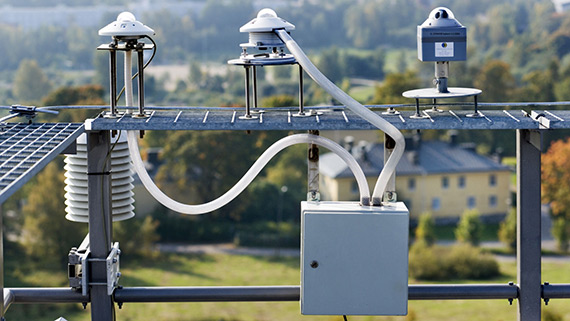Weather observations now and in the future

Weather forecasts produced on the basis of observations have a significant role in how society functions. Observations are utilised in most sectors including road and air traffic, shipping, tourism, energy production as well as agriculture and forestry. Weather forecasts produced for the public are of course also based on observations.
The Finnish Meteorological Institute's observation station network includes 400 different types of stations, which provide information on the weather, the sea, air quality and the parts of space close to earth. In addition to observations made on the ground, information provided by satellites is utilised extensively.
Starting this past summer, the Finnish Meteorological Institute has collected weather observations from the general public via a mobile app. Anyone has been able to report their observations on rain, thunder, floods, wind damage and hail.
"No target number of observations has been set for the project as this would have been difficult to estimate in advance. We have now already [beginning of October] been sent more than 21,000 observations," says Ismo Karjalainen from the Finnish Meteorological Institute.
There have been 8,700 users at this point, of whom half has tried out the service and reported anywhere between 1 and 5 observations. There have been around 80 active users who have reported more than 20 observations.
The most active user has reported nearly 300 observations from the beginning of June.
"Reports have been centred on rain observations, which were added to the app ensuring that the public can always report something i.e. is it raining or not. This will help us gain a better grasp on the potential of the service," Karjalainen says.
A total of hundreds of observations have been reported on thunderstorms, wind damage, hail and floods, but with the exception the August storm named Kiira, the summer period was not very weather-rich with regard to these observation types.
Observations form the foundation of weather forecasting
A meteorologist forecasts weather using weather observations and forecasts produced by weather forecasting models. An observation i.e. information on the starting point, is the foundation of a forecasting model, and the model uses this to measure the atmosphere's conditions from the starting point onward.
The basic variables observed at weather stations include air temperature, relative humidity of the air, air pressure, wind, precipitation amounts, overall cloudiness and the height of clouds, the current weather, depth of the snow and radiation of the sun. Automatic stations produce new observations every ten minutes.

Photo: Antonin Halas
The first weather observation station was established in Helsinki's Kaisaniemi in 1844. In the manual era, stations were divided into weather, climate, precipitation and summer precipitation stations, and their operation was based on observations made by people. A person would read the figures on instruments and make sense-based observations on the current weather and mark down these observations in a notebook. In this respect, reporting one's own observations is a return to the past. Now, we just use a mobile device to report results.
"We have travelled a long road from the 1800s to today. Inventions that have been internationally revolutionising have included that of the radiosonde by Vilho Väisälä in the 1930s. The radiosonde allowed researchers to collect data above ground level," explains Juhana Hyrkkänen Head of the FMI's Observation Services Unit.
The first automatic stations were established in 1981. Automation helps us make weather observations in place where there is no habitation nearby. They also produce a wide range of observation variables in a short amount of time, relay real-time weather observations as well as harmonise the manner in which observations are made.
"During the latter half of the 20th century, the role of remote sensing i.e. satellites and weather radars in the acquisition of weather data has been revolutionary," Hyrkkänen describes.
Satellite observations are based on the measurement of radiation from the ground, sea surface, clouds and atmosphere that leaves Earth and enters space. Weather radars in turn will provide data on where it is raining and how much.
Technology to bring unlimited possibilities
The Finnish Meteorological Institute will continue collecting observations from the public at least until April next year, For the winter, new variables will be added to the mobile app including pedestrian weather, thickness of ice, poor driving conditions and snow depth options as well as forms for precipitation in addition to rain such as snow and sleet.
"The variables selected for winter are those that will bring added value for us at the Finnish Meteorological Institute and especially to our weather services. I would assume that the public is interested in finding out which locations are slippery to walk in and the places where poor driving conditions are prevalent.
Especially pedestrian weather is an interesting observation type as it is difficult to measure with the Finnish Meteorological Institute's instruments. Reports from pedestrians will be collected from the beginning of November, at which time the new observations types will be added to the app.
Public observations are such a new addition to the range of observation types that it is as of yet unclear how they will be applied in practice to work at carried out at the Finnish Meteorological Institute. However, it is certain that the future and technological development will also change the ways in which weather observations are made.
Measurement data is already available from vehicles and in the near future intelligence and sensors will be added to built infrastructure including buildings and lamp posts. But, can we get data in the future for instance by wearing intelligent clothing?" wonders Juhana Hyrkkänen on the possibilities of applying the Internet of Things.
Another big trend is "big data", which means the collection and utilisation of enormous data masses using IT and various analysis techniques.
"Developments achieved with technology and e.g. observations reported by the public open up completely new possibilities for which only our imagination is the limit.
